What’s for dessert? I love dessert! Don’t you? So I’ve asked a few friends of mine to list the best desserts in their cultures. So here we have it – yummy desserts, Italian desserts, simple desserts, quick easy desserts, chocolate desserts, tasty desserts, light desserts, french desserts, fun desserts, summer desserts.
Everything from great desserts to amazing desserts in different countries across the globe. Here are the best desserts in cultures from across the world. Drool on!
Che dolci avete? – Italian Culture, Italy
Tiramisù
By Claudia from My Adventures across the World
Tiramisù is the ultimate Italian dessert, the one most people think about. It is a favorite of locals and of foreigners, and it is usually found in all good restaurants.
The traditional version consists of lady fingers (savoiardi) dipped in coffee and layered with a cream made of eggs, sugar, and mascarpone cheese.
The top layer is usually covered with bitter cocoa powder. Though the dessert was first invented in the region of Veneto, one of the best places in Italy to try tiramusù is Bar Pompi, in Rome. Located in Via Albalonga, near Re di Roma metro station, this is a local institution.
Other than the classic version of this fabulous dessert, it is possible to also try alternative versions such as the banana and chocolate one or the pistachio on.
Che dolci avete? – Italian Culture, Sardinia
Sebadas
By Claudia from My Adventures across the world
Sebadas is a very traditional dessert from Sardinia. It’s only found in restaurants that serve traditional Sardinian food, and it is actually best home made.
A good sebada is a crispy, lightly fried pastry made of flour and water and filled with a very mild cheese (typically a fresh Pecorino, but it can also be done with Dolce Sardo) and lemon or orange grind. It’s served piping hot with local honey.
What’s for dessert? – British Culture, England
Bread and Butter Pudding
By Cora & Helen from Inside Our Suitcase
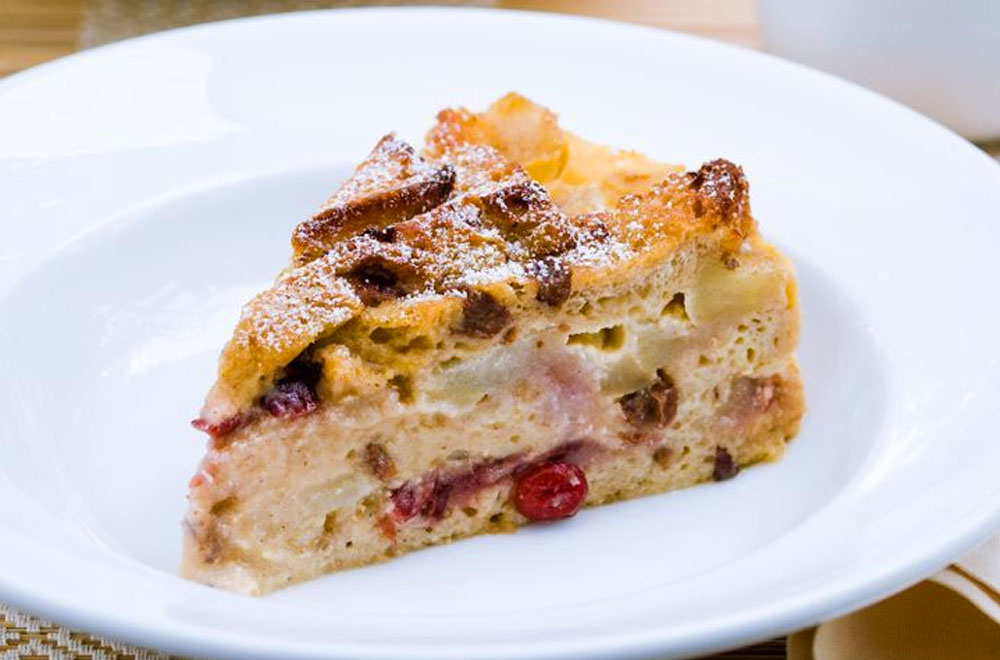
Bread and Butter Should Be For Breakfast… Not Pudding!
Bread and Butter Pudding is one of the oldest dishes on the English menu. The reason I said it should be for breakfast and not pudding, is because it was actually used as both in the 11th century with frugal cooks and included the likes of Bone Marrow under it’s alternative name; Whitepot.
Of course, since then it’s come a long way with British cooks including; Gordon Ramsey, Mary Berry and Delia Smith all having their take on the popular British desert.
Ăn tráng miệng món gì? Văn hóa việt – Vietnamese culture – Việt Nam (Vietnam)
Chè / Vietnamese dessert
By Jackie & Justin from Life Of Doing
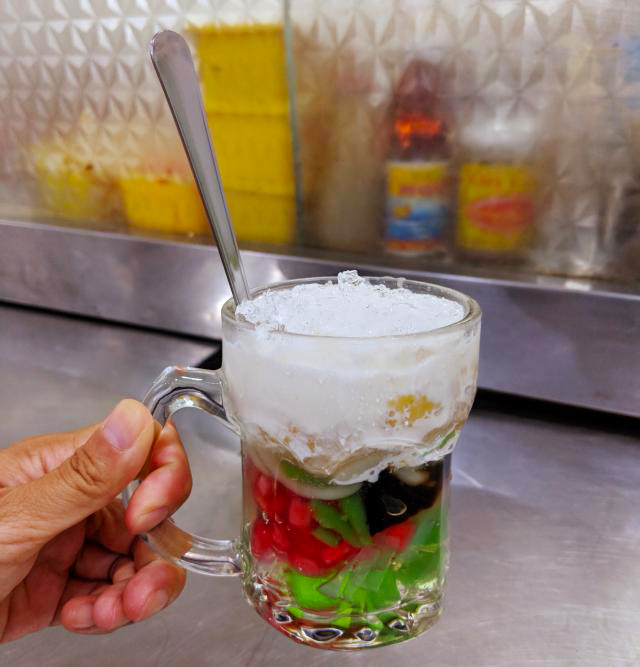
When you’re visiting Vietnam, you have to try chè. It’s a general term that describes Vietnamese desserts in a beverage, soup, or pudding format.
What differentiates chè from other desserts is the use of the decadent coconut cream along with various sweet and savory fillings, such as jellies, beans, fruits, seaweed, corn, rice, seeds, and more.
Chè can be easily found at a local restaurant, market, or at street vendors’ kiosks. Some of the popular chè items are chè bắp (sweet corn), chè đậu đỏ (red beans), chè trái cây (mixed fruit), and chè thập cẩm (combination of ingredients).
It’s the beautiful layers of colorful ingredients, sweetness, and affordability which makes us want more!
Sweets time! – Australia
Pavlova
By Rachel from Adventure and Sunshine
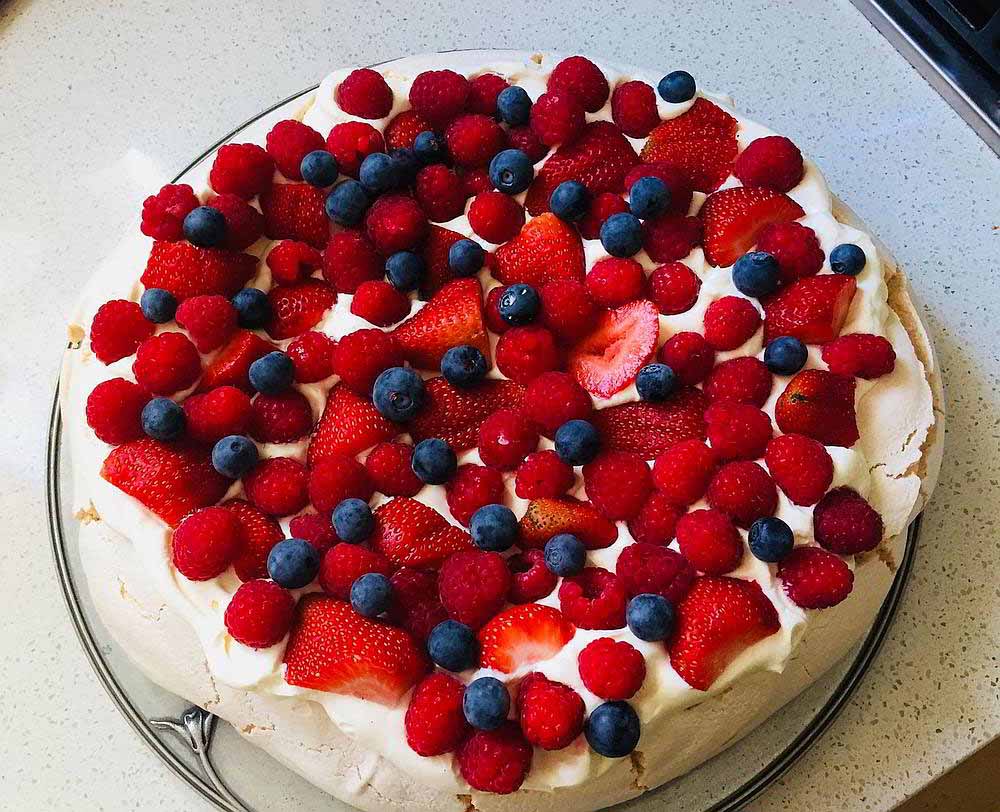
Pavlova, simply known by the locals as ‘Pav’, is a classic Australian dessert. Just don’t mention it to any New Zealanders, who claim the pavlova is their creation too. What can I say? We like to disagree over the origins of things.
What we do agree on is that the pav is named after the Russian ballerina, Anna Pavlova, who visited Australia (and New Zealand) in 1926. The pav is a large cake size meringue topped with whipped cream and fresh fruit and it is the essence of Australian summer.
The meringue when cooked correctly is crunchy on the outside, soft and gooey on the inside. The only word that comes to mind to describe the taste is sublime.
Classic toppings include strawberries, blueberries and passionfruit although there are many just as tasty variations. Easy to prepare, it makes for the perfect dessert on a summer evening.
Qué hay de postre? – Spain
Crema Catalana
By Justine from Latitude 41
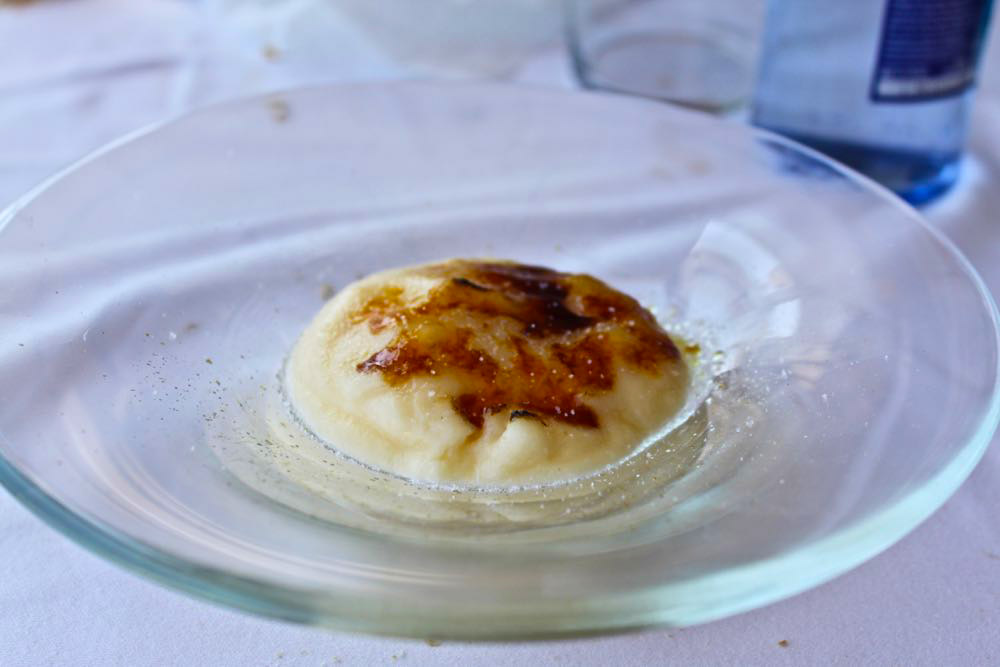
Crema catalana is a dessert native to the northeastern Spanish region of Catalonia, although it’s a national dish enjoyed throughout the Mediterranean country.
It’s a creamy custard with a hard-caramel topping, and it’s often compared to its more-famous cousin, the French creme brulee.
The crema catalana isn’t just as delectable, but it’s easier to prepare. Its base is made with egg yolk, sugar, milk, and is thickened with cornstarch instead of cooked in a water bath like the creme brulee.
After it reaches the perfect consistency, it’s blow-torched or “ironed” to form that delicious spoon-cracking top crust. The crema catalana is so ubiquitous in Spain that inspires its own flavor in other foods like ice creams and turron (nougat).
Always save room for dessert! – California, U.S.A.
Strawberry Shortcake
By Carole from Berkeley And Beyond
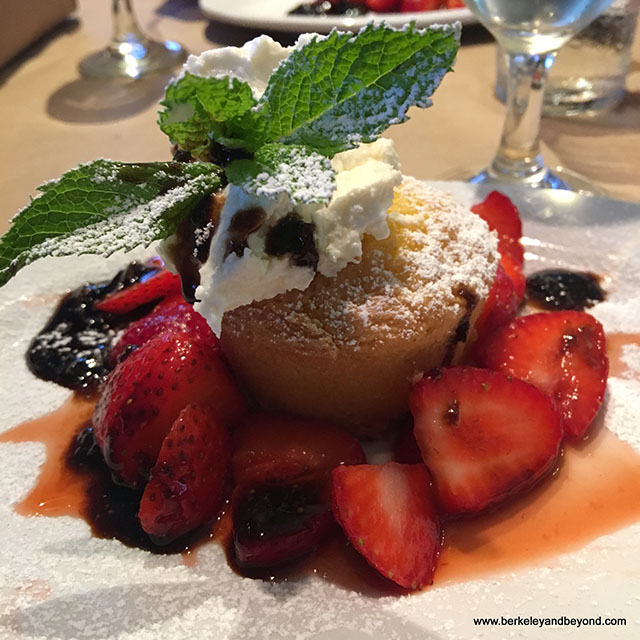
What’s not to love about a dessert that consists of cake, fresh strawberries, and whipped cream?
That’s good enough, but here in California folks sometimes like to take it a step further and make the cake an olive-oil cake, and the strawberries local and organic, and the whipped cream crème fraiche. It’s all good.
I am convinced the reason I love strawberries so much is that my grandfather owned a strawberry farm in Oregon, and as a kid I went there in the summer and helped pick the berries. Grandpa paid me just as he did his other workers, and sometimes I got to see bird nests in the fields.
Hva er til dessert? – Norwegian – Norway
Suksesskake or suksessterte (Success Cake)
By Dhara from It’s Not About the Miles

If you love almond desserts, you definitely have to try Norwegian Success Cake. It is a traditional Norwegian dessert. I tasted it on a cruise of the Baltics we did recently, and I was hooked after just one bite.
Success Cake (Suksesskake) consists of layers of almond meringue with a filling made with sweetened egg yolks, cream, and butter.
The version I had was topped with crunchy sliced almonds. If that sounds decadent, it is! Very sweet, and very rich. But oh-so-delicious!
Que hay de postre? – Cuba
Cazco de guayaba or guava shells.
By Talek from Travels With Talek
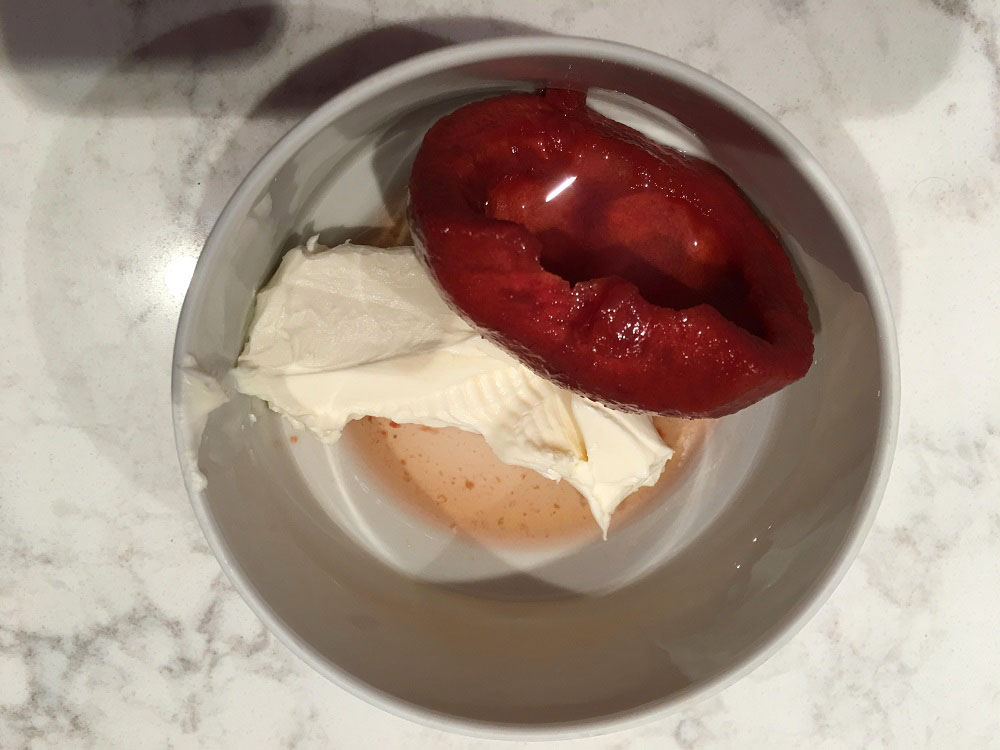
Cubans definitely have a sweet tooth. This is manifested in the wide variety of sweet desserts that can be found on the Cuban table. One of my favorites is “cazco de guayaba” or guava shells.
Many of the Cuban desserts are made from tropical fruits which abound on the island. Guava is a delicious tropical fruit which is cut in half and cooked slowly in a molasses which turns into guava syrup. Traditionally it is served with cream cheese. The combination of tastes is delicious!
Món tráng miệng là gì? – Vietnamese – Vietnam
Chè Trôi Nước or Ginger Rice Ball Soup
By Mary from Move To Vietnam
Chè Trôi Nước or Ginger Rice Ball Soup or dessert wading in water for a more literal translation.
This dessert from Vietnam is made of glutinous rice filled with mung bean paste then bathed in a sweet clear or brown liquid of water, it also consists of sugar and grated ginger root.
Traditionally, it is eaten while it’s still warm garnished with sesame seeds and coconut milk. In today’s time, some people would add a small scoop of crushed ice.
Normally, it is served during Lunar New Year or also known as the Chinese New Year but it is possible to find in on restaurants and local markets any time of the year.
什么是甜点 – Mandarin Chinese – Taiwan
Boba奶茶 – Boba Milk Tea
By Kaila from Nylon Pink

Here is an amazing dessert that will simply blow you away. It’s super sweet and super delicious, and very high in sugar. It has all the makings of a good time!
You first begin by telling the person waiting on you which flavor you want. It’s the perfect accompaniment to a delicious plate of Taiwanese pork chop rice.
In my opinion, Lychee is the best of all the flavors, though I’ve heard strawberry is good too. Then, you see the tapioca pearls being placed into the cup, and after that, you are given your cup and your extra-large straw.
After that, try pacing yourself with the tea. It’s so good and you will just want to keep drinking it. The tapioca pearls are fun and chewy to eat. It makes a very special treat.
What’s for dessert? – Ethnic East Indian Culture, Mumbai, India
East Indian honey balls or snow balls
By Abby from TheWingedFork
Multiply the number of cultures in India by 100 or 200 or 300 and you’ll get the number or sweets we have. Am I exaggerating? Maybe a tad.
But given that we’re a country with a sweet tooth it’s hardly unlikely that we wouldn’t have at least a few dozen sweets per culture. I can count a few dozen just in mine itself.
One of my favorites in the East Indian culture is the snow balls or honey balls. They’re also called aitolas or popoges.
They’re quite similar to the gulab jamuns and rosgullas, but instead of being made of wheat flour or cottage cheese, honey balls are made of semolina or durum wheat.
These lush and light fluffy balls of goodness can be eaten warm or straight out of the fridge.
Wat krijgen we als toetje? – Netherlands
Stroopwafel – syrup waffle
By Edyta from Say Yes To Madeira

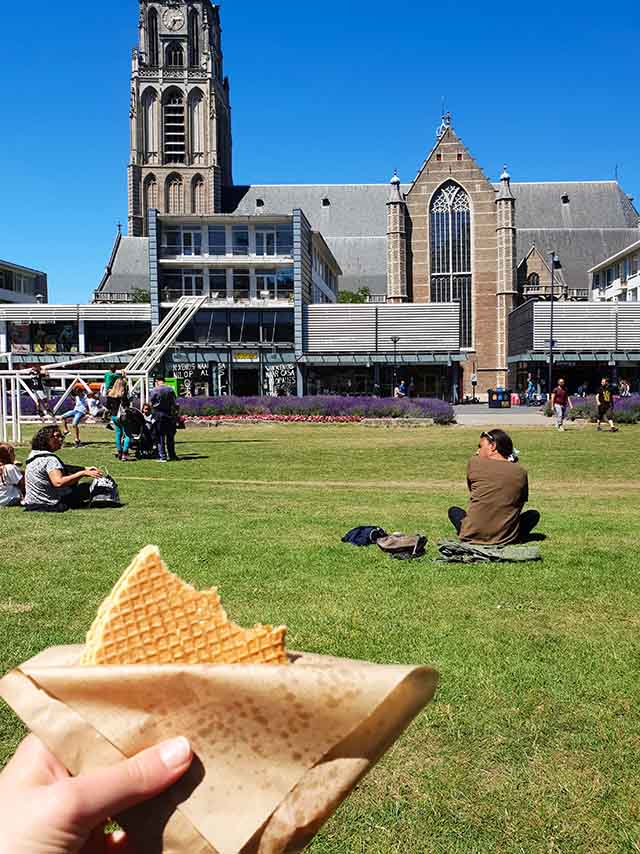
Stroopwafel is probably the most popular sweet treat in the Netherlands. It is a soft waffle made from two thin layers of baked dough, filled with a caramel syrup filling.
The waffles are made of flour, butter, brown sugar, yeast, milk, and eggs. The dough is then placed in a heated waffle iron and pressed into the required round shape.
After the waffle is baked, but still warm, it is split with a knife and filled with a delicious caramel syrup.
Store brand stroopwafels, usually smaller and packed per 10, can we bought in supermarkets or tourist stores, and make a perfect souvenir.
The best stroopwafels are, however, the freshly made ones, which you can buy per piece at one of the many stroopwafel street stands, which can be eaten warm.
Wat is vir nagereg? – Afrikaan, South Africa
Peppermint Crisp Tert (Peppermint Crisp Tart)
By Michelle Minnaar from Greedy Gourmet

Peppermint Crisp Tart is a fridge cake loved by all South Africans. It has not one, but two (!), secret ingredients.
The first one is Tennis biscuit, a South African biscuit made with butter and coconut, which is simply incomparable with any other in the whole wide world.
Another unique product is Peppermint Crisp, which is also only produced in South Africa, which comprises thing cylinder of crystallised mint enveloped in chocolate.
The dessert is made by whipping cream with caramel then layering it with crumbled Tennis biscuits and Peppermint Crisp. A simple must-have when visiting South Africa!
O que tem de sobremesa? – Brazil
Brigadeiro
By Leticia from Happee Travelers

By far the most beloved Brazilian sweet, brigadeiros are very common from children’s parties to local bakeries, desserts at restaurants and they are so popular that there are shops specialized in this delicious sweet, traditionally made of cocoa powder, condensed milk, butter, and chocolate sprinkles.
Apart from the traditional version, there are several others as well, the most popular being “Beijinho” (made with condensed milk, coconut, and a small clove) and “Casadinho” (a mix of brigadeiro and beijinho).
The curious fact about brigadeiro, which means Brigadier in English, is that it was created in the 1940s to support the campaign of a presidential candidate, the Brigadier Eduardo Gomes.
He didn’t win the election, but the sweet became more popular than any politician in the country! It’s a must try, and very easy to make in any country.
K̄hxngh̄wān khụ̄x xarị? ของหวานคืออะไร? – Thailand
Khaw Neaw Ma Maung or Sticky rice with mango
By Jorge & Cláudia from Travel Drafts

Sticky rice with mango is a traditional Thai dessert, a quite simple one but full of flavor. It is made with sweet sticky rice, with delicious mango and coconut milk syrup.
Sticky rice is a type of rice cultivated in Southeast Asia, it’s a glutinous rice that becomes very sticky when cooked.
The rice is soaked in water overnight and then steam-cooked. Afterward, the coconut milk syrup is spilled over the rice and in the end, you join the fresh mango and it is ready to be served. As simple as that…
You can find this dessert all over Thailand, but especially in the north, from food stalls to traditional Thai restaurants. Note that Thai use Sticky rice with nearly every dish, not only on this dessert and it is served without any seasoning.
Sticky rice with mango is best eaten warm and it comes in different variations, like colored sticky mango. This dessert is considered one of the best Thai dishes.
Pencuci mulut – Indonesia
Es Campur
By Halef from The Round The World Guys
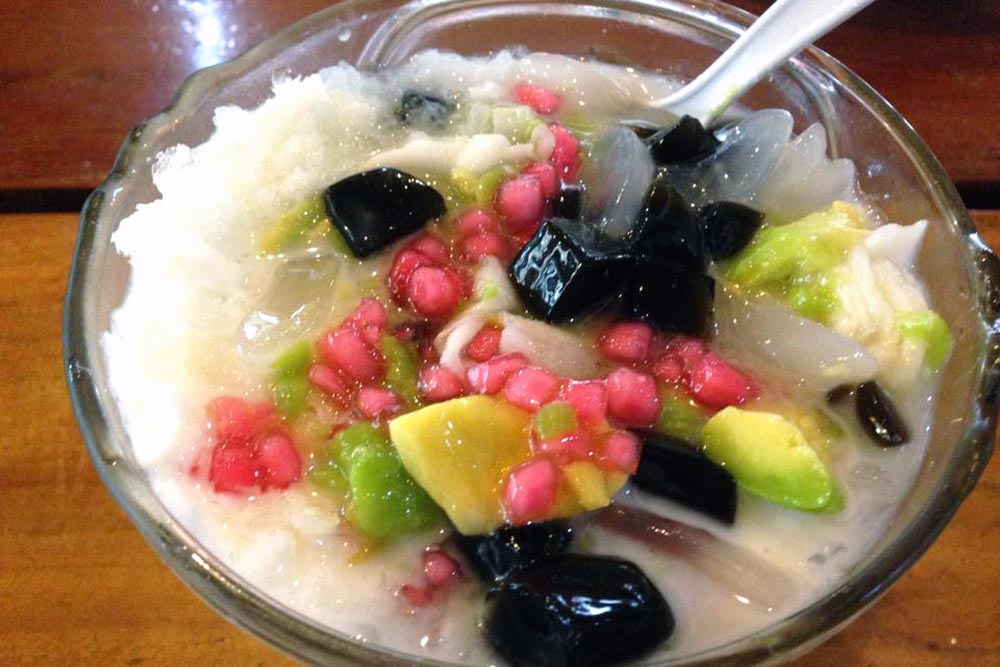
Es Campur is one of the most favorite desserts in Indonesia. It is a mix of shaved ice, young coconut, various fruit, grass jelly, and syrup, as well as condensed milk. My favorite is the avocado slices in the mix.
You can find this refreshing dessert everywhere in Indonesia, from the street vendors and trolleys to big name restaurants. During Ramadan, es campur is a popular dish for Indonesian Muslims breaking their fast.
So, how do you say ‘what’s for dessert’ in Indonesian? Well, there’s not really a great translation, as Indonesians typically don’t have structured meals like everywhere else.
Dessert is just a snack that you can eat at any time of the day. ‘Pencuci mulut’ is the closest words for dessert – it literally means food or drink to wash your mouth. Here are a things you should know about Indonesian food.
Qu’est-ce qu’il y a comme dessert chez les Bretons, en France? – Francais, France
Crêpes in Brittany, France
By Elisa from World in Paris

In France, there is no better dessert than a warm, sweet crêpe with your favorite filling. Crêpes are original from Brittany but they were adopted in Paris, and all France, very soon.
In France, going to a crêperie is a popular activity to do with friends or family, but crêpes are also very easy to prepare at home if you have the right tools.
The dough is made with wheat flour, eggs, and milk and you can fill it with things like jam, Nutella or, my favorite, just sugar, and lemon juice.
Usually, crêpes are served with wiped cream or ice cream on the side and people like to eat them with cider or coffee, depending on the time of the day. Crêpes have their own day in the French calendar: 2nd February it is the crêpes day!
This is one of my favorite French food festivals in France because you can find crêpes everywhere, even some food trucks make them.
मीठे में क्या है? – उत्तर भारतीय संस्कृति, भारत (North Indian Culture, India)
Sooji ka Halwa or Semolina Pudding
By Anjali from Travel Melodies
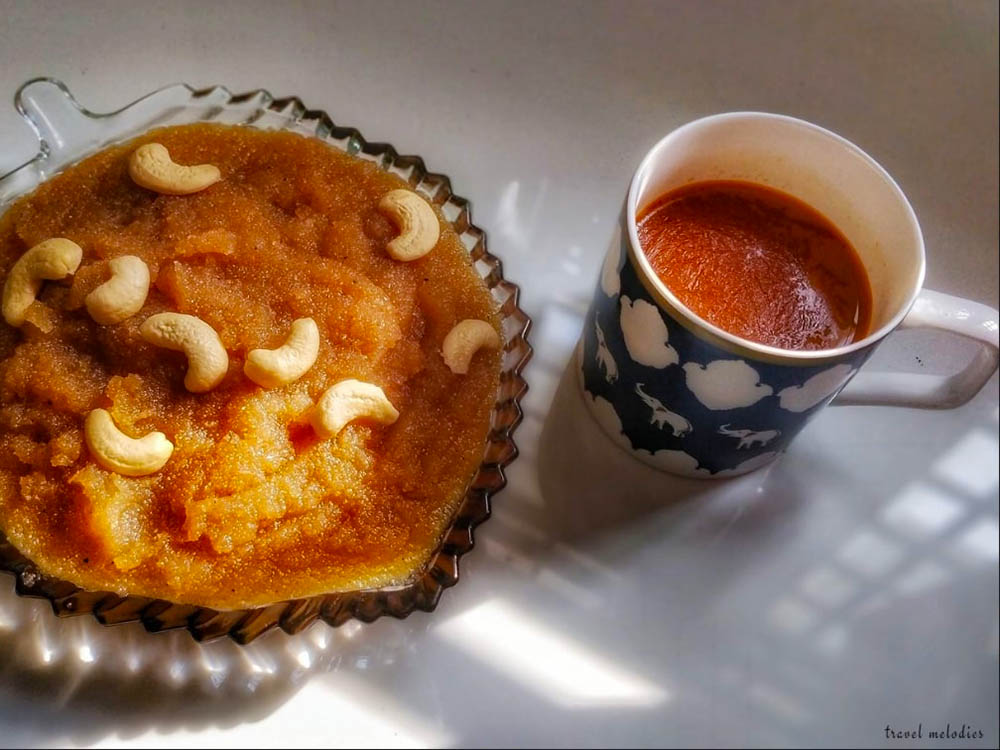
I grew up eating sooji ka halwa. Sooji ka halwa is an Indian dessert made from semolina. In North Indian culture, sooji ka halwa is being considered sacred.
Temples and gurudwaras use sooji ka halwa as prasad (devotional offering.) We prepare this sweet dish on almost every religious occasion.
Just the mention of sooji ka halwa brings back fond childhood memories. I remember how my mom would prepare sooji ka halwa and serve it with poori on Sunday mornings.
It’s easy and takes a few minutes to prepare it. The ingredients are readily available in all Indian households. One needs water, sugar, saffron, semolina, cardamom, dry fruits and lots of desi ghee (Indian version of clarified butter.)
The dessert is greasy but sinfully delicious. Let go of the food guilt and enjoy as the halwa melts in your mouth. Couple it with a hot cup of chai (Indian masala tea) and feel the magic.
Ce avem la desert? – Romania
Papanași
By Andra from Our World to Wander

Well, if you visit Romania, this is one word that you will definitely need to learn. The mouth-watering papanași, pronounced as pa-pa-nashi.
It’s one caloric bomb for sure, but then again you aren’t having it every day, so you might as well spoil yourself.
It’s actually a dessert made of donuts, which are filled with a type of soft cream, they then fried and covered with sour cream and forest fruit jam.
It is considered to be a traditional Romanian dessert and you can easily find it in a lot of restaurants. And you will surely be charmed by this mix of flavours, as you get the sour cream combined with the extra sweet jam.
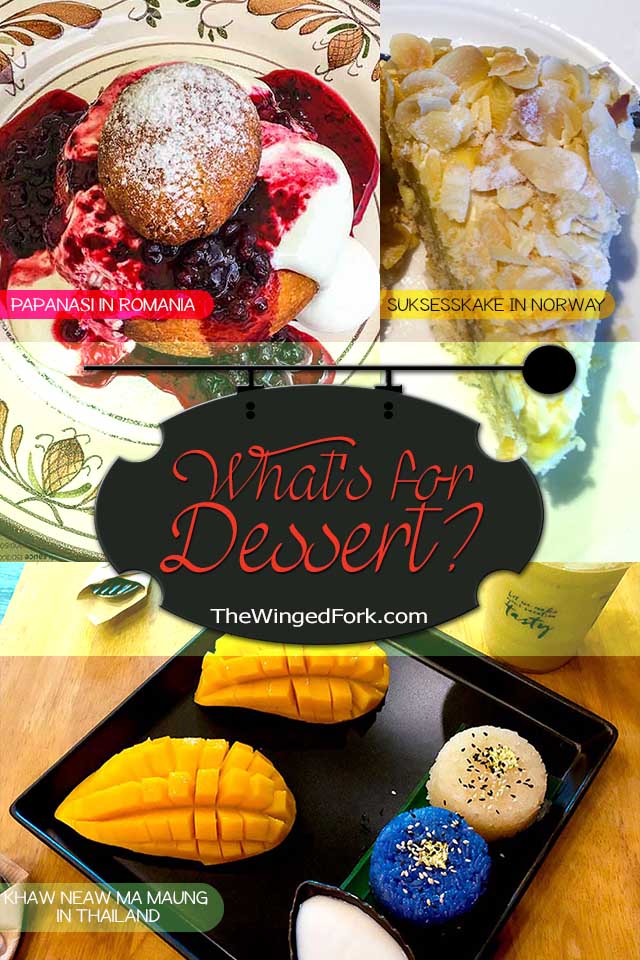
디저트가 뭐야? – Korean culture – South Korea
팥빙수 (Patbingsu)
By Jae Park from Adventure Dragon

Shaved iced desserts are incredibly popular in South Korea. The ice is so finely shaved that it has a soft consistency more like ice cream rather than ice.
Sometimes the ice is even combined with a flavored milk base before shaving which results in the end product becoming even creamier.
To make patbingsu, this shaved ice is then topped with condensed milk, fruit, mochi (rice cakes), and red beans.
The red beans are the most important part. They’re incredibly sweet and used to make many desserts in South Korea, just like jujube is used to make bingsu in the Korean autumn.
Patbingsu translates to “red bean shaved ice dessert,” in fact, and it’s one of my favorite summer treats.
Tatlı için ne var? – Turkey
Baklava
By Allison from Sofia Adventures
One of the most famous desserts of Turkey is baklava, a dish so loved that it has made its way around the globe.
This dessert is popular not only in Turkey but in several countries in the region that were occupied by the Ottomans such as the Balkan countries or traded with them frequently, like Egypt.
Baklava is made of phyllo dough, honey, and nuts. The most typical nut used in Turkey is pistachio, which is my personal favorite kind of baklava.
However, in other countries, other nuts are more popular – walnuts are a popular nut used in this dish. I love it because it is flaky, sweet, sticky, and super rich, and the textures are fantastic!
Wos gibs zua Nochspeisen? – Österreich (Austria)
Blueberry Kaiserschmarrn
By Helene from Masala Herb
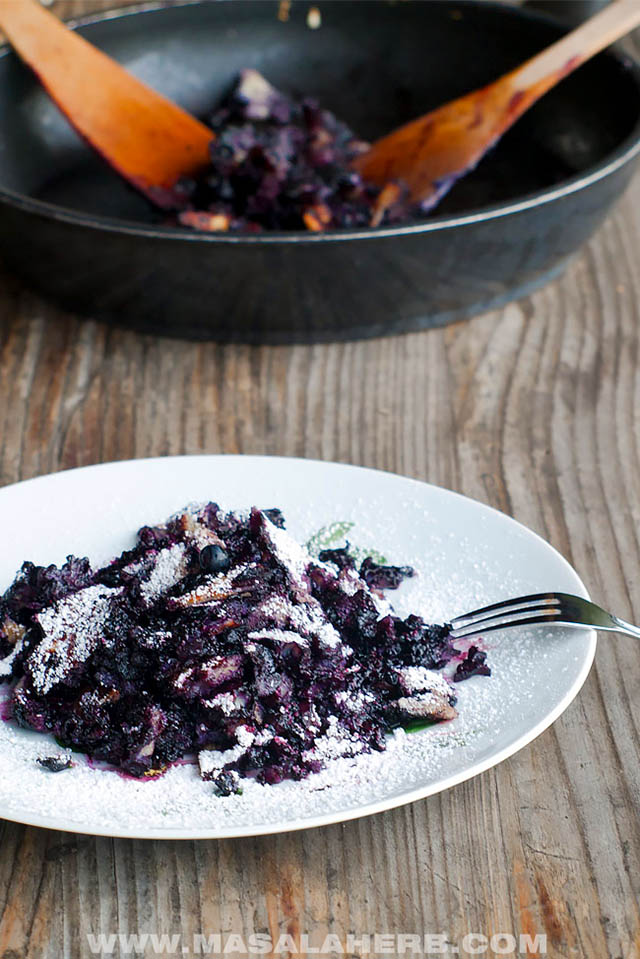
Kaiserschmarrn means “imperial mess/nonsense” translated from the Austrian Viennese German. Before the Austro-Hungarian empire was taken apart, Vienna was the capital and the emperor was Franz Joseph.
His personal imperial chef came up with the dessert Kaiserschmarrn, which was the emperors favorite dessert. Basically it’s a fluffy melt in the mouth scratch pancake. The egg whites are turned into peaks, lending the Kaiserschmarrns the lightness.
The chef obviously thought it to be a weird request from the emperor to scratch the pancakes, nonetheless it was proudly called the Kaiserschmarrn. The region of Tyrol in the west of Austria is known for the alps, beautiful nature and tough people.
In Tyrol we have a farmers version of the Kaiserschmarrn, you can call it the poor men’s Kaiserschmarrn with Blueberries. We know it as “Miasl” in our Austrian German mountain dialect (which doesn’t have any translation).
Farmers own forest lands in the mountains and that’s where the blueberries grow in July and August. Because farmers don’t have time they just dump all the ingredients together instead of turning the egg whites into peaks. This is how the Viennese Kaiserschmarrn was adapted by the locals in the Tyrolean alps.
Qu’est-ce qu’il y a pour dessert? – North East France
Madeleine shell cakes
By Helene from Masala Herb
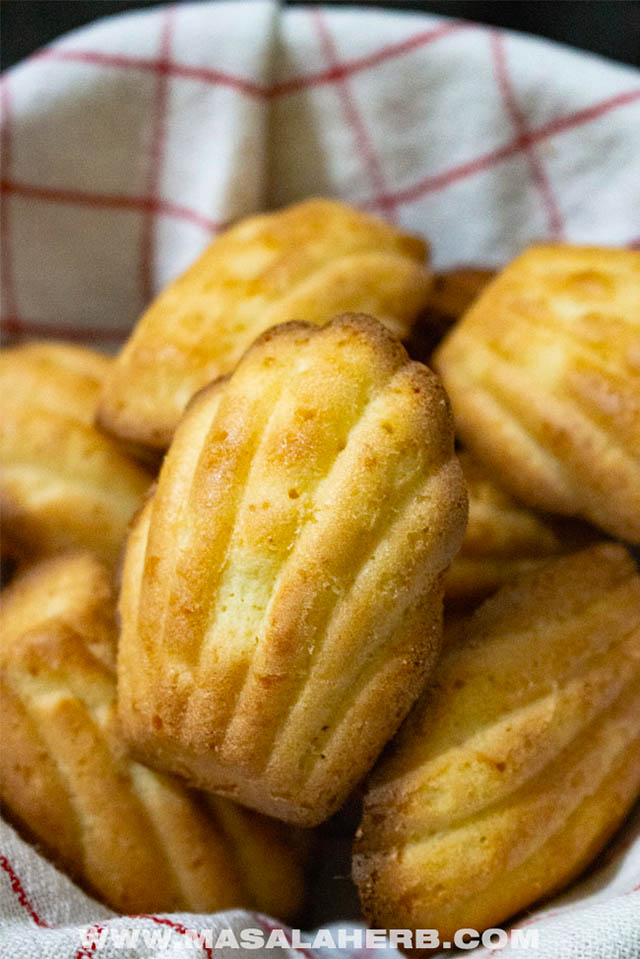
I grew up eating madeleine cakes, which are shell-shaped bite-sized soft cakes. Madeleine cakes originated in the region of Lorraine, which is situated next to the french wine region Alsace and touching the German border.
My mum’s family was partly from the Lorraine before WW1 and the family recipe is kind of a heirloom. How madeleine cakes came to be exactly is not very clear, some say a lady called Madeleine came up with these sweet little potable cakes.
Yet, what is well known is that women would sell baskets full of freshly baked Madeleine at the railway stations in the Lorraine.
Madeleines were super fragrant (because they are prepared with orange blossom water) and the ladies would make sure that everyone knew what they were selling by screaming out “Madeleines, Madeleines.”
So, travelers would buy a few Madeleines while the train was slowly leaving the station. That way the popularity of the Madeleine cakes was spread all over France and the world in a very convenient way.
Was gibts als Nachtisch? – Wiener, Österreich (Vienna, Austria)
Apfelstrudel (Apple strudel)
By Marie from Travelers Joint

The Apfelstrudel or Apple strudel which means apple whirlpool is a popular Viennese pastry that has been around since 1697. It is a staple in most Austrian as well as other European restaurants as dessert and in coffee shops or cafés as a light snack.
The Strudel (commonly how it’s called in English today), is made by filling a pastry jacket with cubed or grated cooking apples, cinnamon, sugar, raisins, and sometimes bread crumbs.
Depending on the region, the pastry jacket could be different, too. The Strudel is fairly common in countries that were once under the Austro-hungarian empire but has varied from the original through the years.
In Austria, where it is listed as one of the national dishes, the Strudel is served sliced, covered in powdered sugar, with either vanilla ice cream on the side, or swimming in vanilla sauce.
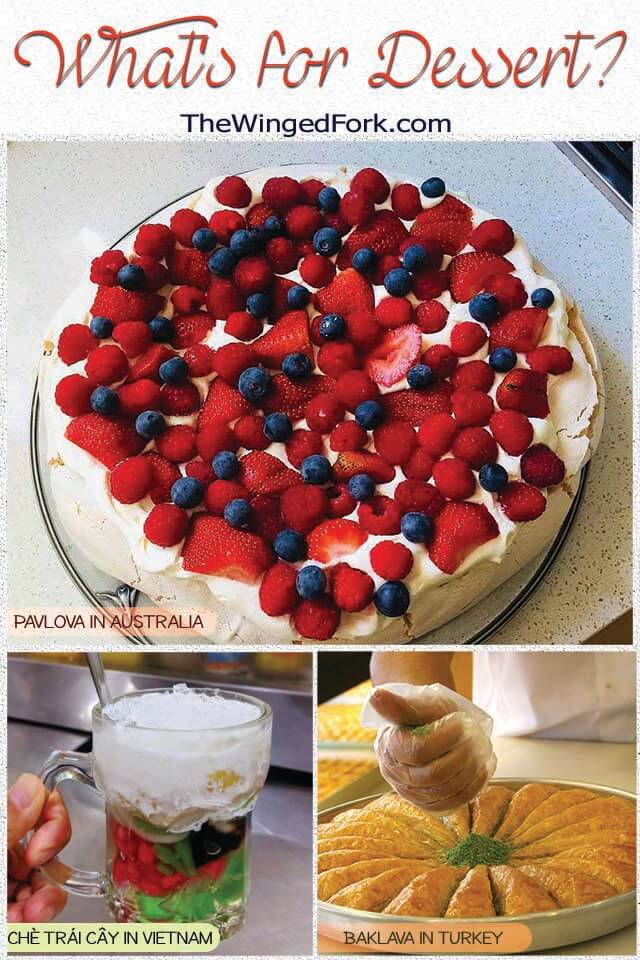
Was gibts als Nachtisch? – Austria
Mohr im Hemd (Moor/Black man in a shirt)
By Marie from Best Vacation Places

This Austrian sweet is mostly made from chocolate, butter, bread crumbs, sugar, yolk, almonds and red wine, a dark version of the bundt cake.
When served, the cake, small as it may be gets smothered with chocolate and is served with whipped cream on top or sometimes ice cream. It is my favorite among Austrian desserts.
The term Mohr was a German term for people with dark skin, or Moor in English (not used to this day). Im Hemd literally means “in a shirt” in reference to the (white) cream covering the chocolate cake (pardon my photo as I only put the cream on the side), thus the name Mohr im Hemd or Moor in a shirt.
This has of course caused controversy with backers stating that the term is discriminating. Defenders explained that the term is being used exclusively nowadays in art, and has no particular reference in history to claims of discrimination.
Whether called Mohr im Hemd, or by the suggestions Schokokuchen mit Schlag, Schokohupf or Kakaohupf, this yummy treat remains to be a favourite among locals in cafés and restaurants.
Anong pang-himagas? – Filipino/Spanish Culture – Philippines
Leche Flan (Milk flan)
By Marie from Banana Mango

This creamy dessert made of eggs and milk is more commonly known to sweet tooths as Crème caramel. The Philippines was heavily influenced by the Spaniards after being a colony for 333 years, and the Leche Flan is one of those that lingered.
Flan in Spanish-speaking countries may exclusively mean crème caramel, and it’s their version that the Filipino dessert was derived from – just made with condensed milk and more egg yolks than the Spanish original.
Like most crème caramel, the sugar syrup is cooked to a caramel consistency then poured into mold before adding the custard base.
It is usually cooked in a bain-marie on a stove top but nowadays, also in the oven in a water bath. When cooked, it is turned and served with the caramel sauce on top poured over. What I like to add when making
Leche Flan is lime zest, to make it not too sweet for the palate. Leche Flan is also a popular addition to the Filipino shaved ice cream dessert, halo-halo.
Ce avem la desert? – Romania
Vegan Muffins (Briose Vegane)
By Cris from Look N Walk
I come from a family that used to do very elaborate meals on Sundays and holidays, complete with scrumptious desserts. But, as I started to learn about nutrition I’ve drifted away from the traditional Romanian foods.
And when I switched to vegan, I made sure to start including vegan desserts for my family. Last Christmas, I made all the desserts, and all were vegan…and a major hit. Among them? My signature vegan muffins.
I used to bake muffins when I was a vegetarian, too, so I just replaced the egg with a banana and the cow milk with plant-based milk and voila! Depending on my mood and what my freezer and pantry are stocked with, I also add frozen fruits and bits of walnuts.
The recipe is almost the same as a cake made during Lent, called “chec” (literally translated to “cake”). Except the traditional recipe doesn’t include a banana. It may include walnuts though.
Was gibts als Nachtisch? – Viennese Culture, Austria
Sacher Torte
By Laura from The Culinary Travel Guide
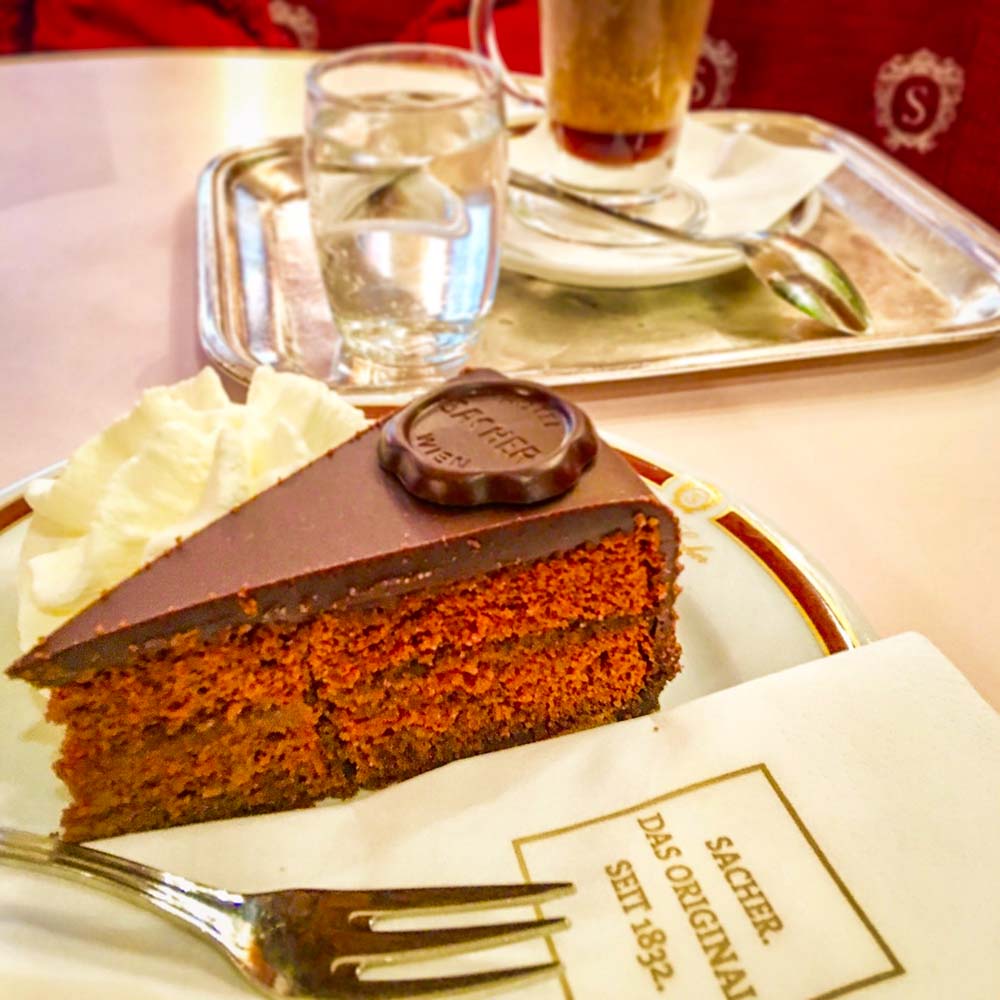
The Sacher-Torte is the city of Vienna’s most famous cake. Decadent and rich, this chocolate cake was invented in 1832 by Austrian Franz Sacher, an apprentice chef for Prince Wenzel von Metternich.
Although the original recipe remains a secret, all versions are made with a dense chocolate cake that is thinly coated by hand with the best quality apricot jam. The cake is then topped with chocolate icing and served with unsweetened whipped cream.
Get your fix at the elegant Café Sacher, a Viennese institution located just behind the Vienna State Opera.
ماذا هناك للتحلية؟ – Arabic Culture, United Arab Emirates
Cheese Kunafa
By Sarah from Hungryoungwoman
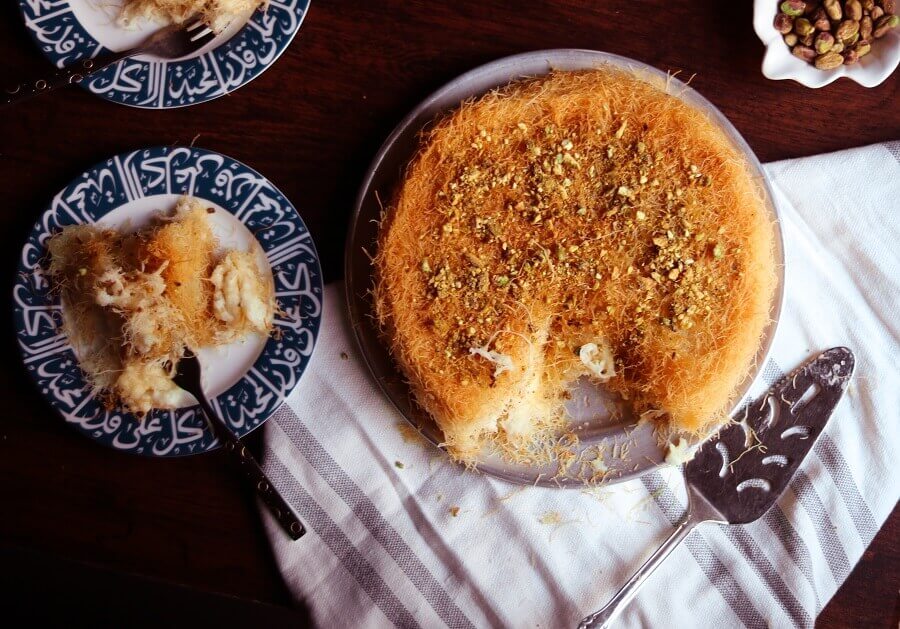
Cheese Kunafa is an Arabic dessert that uses shredded Kataifi pastry and cheese as the main ingredients. The dessert is usually eaten during Ramadan as part of Iftars in Arabic countries like the United Arab Emirates and the Middle East.
It is traditionally filled with Akawi Cheese which is washed, drained, and then squeezed to give a soft texture similar to cream cheese, but to make it versatile, I tried using mozzarella as the filling and it just worked like a charm.
The kunafa is then layered and put to bake, after which you can taste the simplicity of the dessert! You can check my recipe here where I use only 3 ingredients to make a delicious cheese kunafa in the comfort of your home.
आज जेवणात गोड काय आहे?- Maharashtrian Culture, India
श्रीखंड (Shrikhand)
By Abby from The Winged Fork

Shrikhand is a traditional dessert from the state of Maharastra in India. It’s made from hung curds or yogurt that the water has been drained from. The curd is beaten with sugar and cardamom or kesar for flavor. Crushed pistachios or almonds are sprinkled on the shrikhand before serving.
Nowadays, you find many flavors of shrikhand in the market, such as mango, sitafal (custard apple), grape, and many more.
In India, sweet dishes are traditionally eaten along with the meals instead of after. The age-old knowledge of our ancestors says that eating the dessert with food is less strenuous on the liver because the dessert is broken down and digested along with the food.
As opposed to that eating dessert after a meal, supposedly sends the liver into quite a frenzy. My friends say this has been scientifically proven. I haven’t read up on it yet. Have you?
デザートは何ですか? – Tokyo, Japan
Daifuku
By Chad Thiele from TokyoSpark

Daifuku is one of those dishes that really throws people off the first time they see it. It’s hard not to fault them.
It looks like a white, or often pale pink, doughball of sorts. It’s soft, somewhat sticky, and sometimes even has dark lumps showing through depending on the filling.
To understand daifuku you must first know what mochi is. Mochi is rice that has been pounded into a glutinous dough-like consistency. Then, to create daifuku, a small round of mochi is stuffed with a filling.
In the photo, it is stuffed with a strawberry and sweet anko bean. But you will find them with a wide variety of fillings.
Nearly all are delicious, some will test your palate, while some will check your willpower. It all depends on what you like in a dessert.
My favorite thing about daifuku is it is very portable, easily consumed, and nearly every shop you buy them from offers a unique flavor.
I’m dreaming of liquid chocolate fountains and marzipan castles. Or should it be marzipan hills and chocolate rivers since I did once help sis to decorate a cake that was exactly that. Luscious and rich and sweet enough for a dozen people. But as usual, I digress. Back to the question at hand. What dessert on this list was your favorite? Comment and let us know.
Other Foodie Posts You Might Like
- Where to eat in Chania, Crete
- Did you know this about the tacos al pastor?
- A nurse traveling the world
- Mexico City’s most popular hotspots
- Where to stay in Goa

What else should be on this list? Ping me at abby@thewingedfork.com with a description and picture and I just might add it in. Till next time! Have the sweetest day!
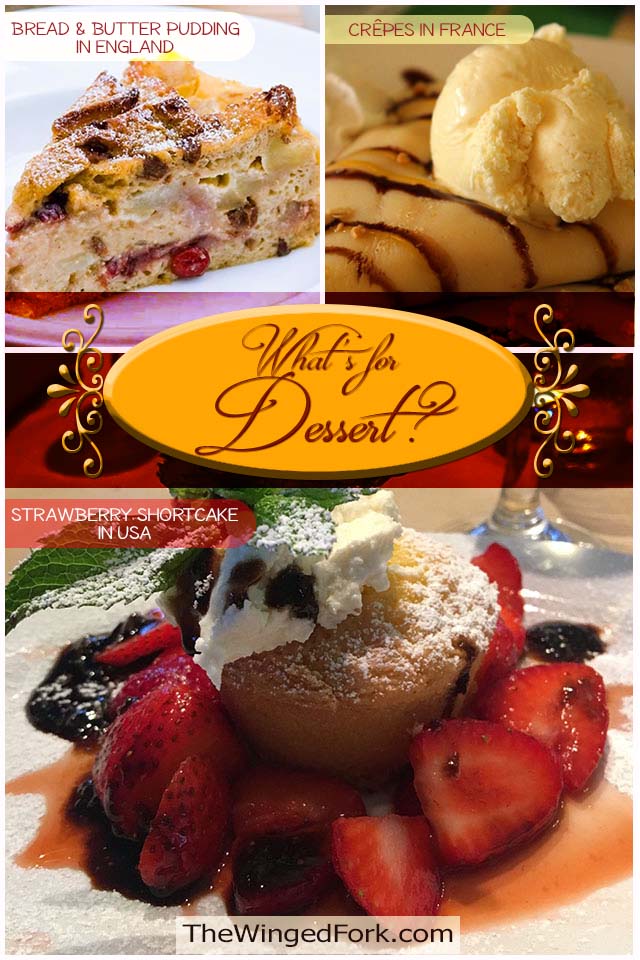
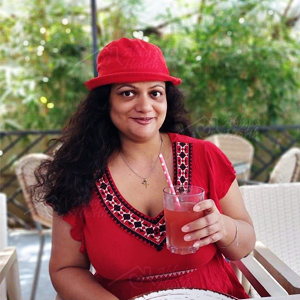
I’m an East Indian foodie and travel blogger from Bombay, India. I’ve travelled across parts of Europe and Asia, and love writing about my experiences with people and cultures. And naturally, I love food, wine, and travel, and have an endless bucket list of places to go to, and experiences I must blog about.
I also love baking and experimenting with food, with a little help from my family. If you must know, my favorite things are nice rainy days, the smell of cakes in the oven, playing in the snow, glasses of wine, and dark chocolate.
More info about me here!
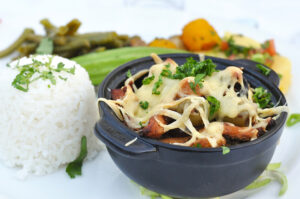
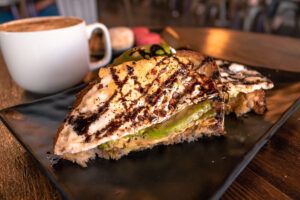

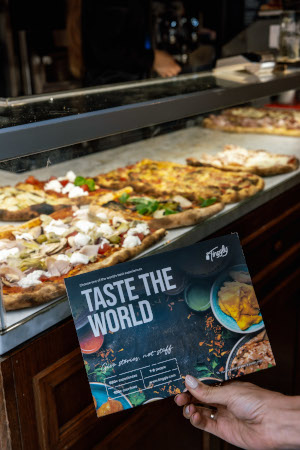
D e l i c i o u s! This post is so nice, but a real torture for someone on a diet 😉 All these desserts are spectacular, Povlova is definitely my favourite. Looks and tastes great.
Thanks Edyta! They are all lush, aren’t they? I’ve added so many to my list of must try desserts. 🙂